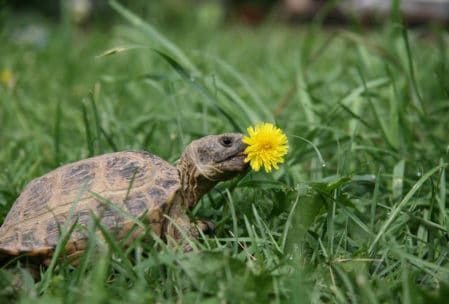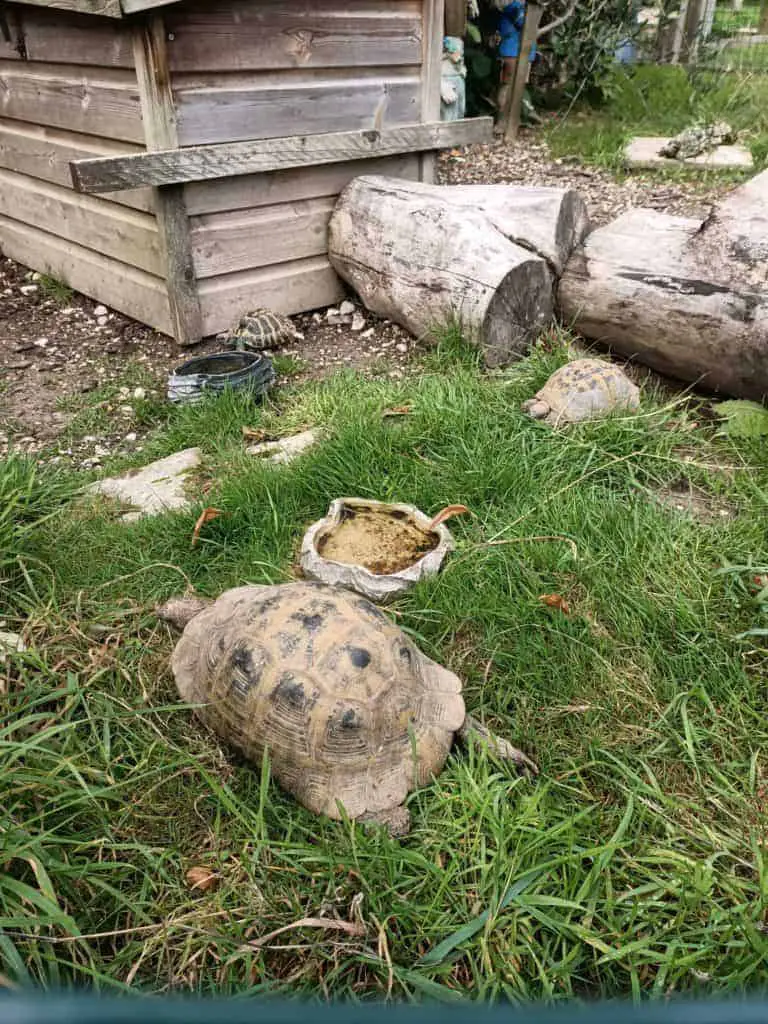
It’s a subject that comes loaded with a fair amount of contention: When should tortoises (if ever) be kept outside, especially in colder northern climates such as the UK?
The first thing to say is that some species are more suited to living in the UK than others, and you can read more about that here.
Most literature will tell you, quite rightly, that a tortoises natural habitat is outside, therefore the correct and humane thing to do is keep them outside from the get go.
When I first bought my hatchling Hermann’s tortoise I was pretty nervous about letting him live outside, especially here in the UK, where let’s face it the weather hardly matches up with the mediterranean climate of a Hermann’s homeland.
Furthermore, much of the literature also states that tortoises should be brought inside in the evening and placed in a warm vivarium to protect them against cold night time temperatures. For my money, daytime temperatures all too often equal those of the night, which doesn’t make leaving them outside during the day an attractive prospect in the first place.
If you’d like more detailed information on caring for your tortoise, all in one convenient place, be sure to check out our species-specific eBooks on tortoise husbandry. These cover everything from properly setting up your tortoise habitat (both outdoors and indoors), to correct heating, feeding and breeding management.
Keep Juvenile Tortoises Indoors
I’m sure there are those who would scream at me for it, but to me it seems much more sensible to keep tortoises, particularly younger ones who have less resilience to colder temperatures, inside for at least the first couple of years of their life, sustained by the optimised conditions within their vivarium or tortoise table.
For our top picks of essential items for tortoise care, particularly for indoor living, check out our recommended tortoise care products.
Much of the argument for keeping even juvenile tortoises outside stems for the need for them to breathe fresh air and be exposed to natural UV light. These are totally fair points, and in an ideal world I wouldn’t disagree with this at all. However if your situation is anything like mine, then your ‘outdoor’ conditions aren’t exactly conducive to your tortoise thriving in one or both of these respects.

In my case my garden is north facing, so it’s extremely difficult to access a decent amount of sunlight anywhere in the garden, therefore the consistency of the UV light I have indoors is far more inviting most of the time
Similarly you might live in an inner city area where the prospect of ‘fresh air’ outside is dubious to say the least, and you might feel more comfortable keeping your tortoise indoors away from the onslaught of industrial pollution and vehicle exhaust fumes.
Having said all that, if your outdoor environment is clean and bright then there’s no harm in keeping your juvenile outside on warmer summer days, provided you’re prepared to provide the right enclosure and conditions, even for short stays of just a few days a year.
Keep Older Tortoises Outside More Frequently But Exercise Caution

As mentioned above, I wince at the thought of keeping even the most hardy of mature tortoises outside all year round in our cold northern climate. Therefore even when they ‘come of age’ I would only let them spend their days outside on days when I was sure it was hot enough for them to be there.
Year Round Outdoor Living
There are of course those who will keep their tortoises outside all year round come rain or shine, and find that their tortoises suffer no ill effects as a result. For the most part I would consider this a pretty dangerous game, but especially so with some species over others, as well of course as those who are in poor health.
Indian Star Tortoises for example are known for being difficult to look after, being prone to infections and weakened immunity as a result of being kept at lower temperatures.
Overwintering: Which Tortoises Should Definitely Be Brought Inside For Winter?
Not all tortoises are well suited to live in the UK.
Some tortoise breeds hail from tropical environments (ie. those that are close to the equator and hot all year round) and as such do not naturally hibernate. This makes them especially vulnerable if they are left outside during the cold winter months, as their metabolic rate doesn’t decrease in line with the reducing temperatures and they will instead struggle to survive.
Popular Tropical Tortoises:
- Red Footed Tortoise
- Cherry Head Tortoise
- Indian Star Tortoise
- Leopard Tortoise
If you keep a tropical tortoise outside during the warmer months of the year, you’ll definitely need to bring them inside during the winter, and ideally match the temperature and UV exposure they’ll have been receiving outdoors.
Which Tortoise Breeds Can Be Left Outside All Year (In Theory)
Mediterranean tortoises, such as Hermanns and Spur Thighs as well as Russian Tortoises and other asian varieties can, in theory, be left to hibernate outdoors throughout the winter.
Again, I would only attempt this with older specimens that are fighting fit and free of any disease or parasitic infection. You’ll also need to be sure their enclosure remains dry, and can’t be invaded by any other animals or vermin.
Of course hibernating tortoises are only able to hibernate successfully when the ambient temperature around them drops below a certain temperature (typically around 10 degrees celsius), so you will still need to keep them in a comparatively cold area of your home even if you do bring them indoors to hibernate. The major advantage of course, is that you have control over letting it get unnecessarily cold, as well as completely eliminating the risk of frost and predators.
Correct Set Up For A Tortoise Living Outdoors
Keeping your tortoise healthy outdoors is of vital importance, especially if you intend to allow him or her to hibernate out their during the winter. Even rainy days throughout the rest of the year can cause problems with a poorly designed/constructed enclosure, so getting this right is priority number one, before you even think about putting your tortoise outside.
Keep The Moisture Out
Whether you intend to buy or make your outside enclosure it’s vital that the covered area where the tortoise will most likely choose to sleep is totally watertight.
A little bit of humidity for most tortoises is of course vital to their wellbeing, but being drenched for months on end will leave them in a state akin to the soldiers of World War One and their horrific experiences of trench foot. For tortoises who can’t get away from wet ground, and are instead forced to sleep on it, shell rot is a very real possibility.
Shell rot occurs when the tortoise’s shell isn’t able to fully dry out for any length of time, thereby allowing bacteria to grow, and ultimately causing tortoise’s shell to start rotting away. Left untreated this condition can be very serious, so it’s best to avoid it in the first place.
Moisture from above doesn’t tend to be the biggest issue with an outdoor tortoise enclosure, provided a properly constructed and damp proofed roof is present. The real issue is ground water either leaking into the enclosure, or there being no base to the enclosure in the first place. Under no circumstances should tortoises be left to sleep on grass or soil.
The best way to prevent groundwater creeping in is to have the entire enclosed part of the tortoise run elevated above the ground. Much like a rabbit or guinea pig hutch is usually mounted on legs, the same should be true for a tortoise enclosure. An access ramp is necessary to allow the tortoise to come and go, although obviously this needs to be be smooth without the wooden steps sometimes found on a the hutch ramps of our furry friends.
Keep Predators Out
Whilst it’s okay to let your tortoise roam free in your garden when you’re around, there are too many potential dangers to leave them completely exposed to the elements when you aren’t.
A covered enclosure is the solution, and by covered I mean covered with chicken wire or mesh that allows natural light and fresh air in whilst keeping cats and birds out. The bigger this space can be the better, but at the very least try to match the size of your indoor tortoise table. The enclosed and raised enclosure will need to sit within this space.
If you’re concerned that foxes will be a problem, then you’ll need to make the enclosure even more secure. Foxes are able to burrow underneath animal runs in order to get inside, so you might need to go all out and dig down a good couple of feet and put in a solid barrier around the perimeter to make it more difficult for them to tunnel their way in.
Unfortunately if a fox does manage to get to your tortoise, even if the tortoise survives the initial attack and is dragged away by the fox it would be difficult for you to track him or her down again.
Keep The Tortoise In!
Just as some predators are able to burrow their way into an outdoor tortoise enclosure, so too can tortoises burrow their way out of one. Tortoises are known to be vivacious diggers, which might come as a surprise to some, but it’s definitely something you need to be aware of.
The solution to this is the same as the problem of keeping predators out; ensure you extend the perimeter barrier below ground, at least 6 inches, but ideally one or two feet.
Take Advantage of The Space
The great advantage of keeping your tortoise outside is of course that you tend to have a lot more room to play with. This means you can go to town more with making a pleasant and more natural habitat for the tortoise to live. You can include more features for climbing, different places to eat food from, and perhaps even a space to cultivate weeds such as dandelions that are a great natural source of nutrition.
Is Heat and UV Lighting Needed Outside?
Provided you have a sunny garden suitable for a tortoise to bask in you shouldn’t need UV lighting at all, if you do then it probably means your garden isn’t a suitable space.
As for heating, personally I would avoid applying heat to outdoor enclosures, if the outdoor temperature is too cold for a non hibernating tortoise, then they should really be brought inside your home where regulating the temperature is easier to do (not to mention more economical).
Many tortoise owners have their own methods to maintaining outdoor conditions for their tortoises, including having ‘greenhouses’ for their tortoises to retreat to when in need of warmth, but again you’d need to be able to carefully monitor the temperature of such a space, particularly if the tortoise is hibernating. If the space gets too warm then the tortoise will come out of hibernation early.
One idea I do quite like (but have yet to try) is to use a heat lamp on a timer set to come on in the morning for a short time, just to get the tortoises moving.

